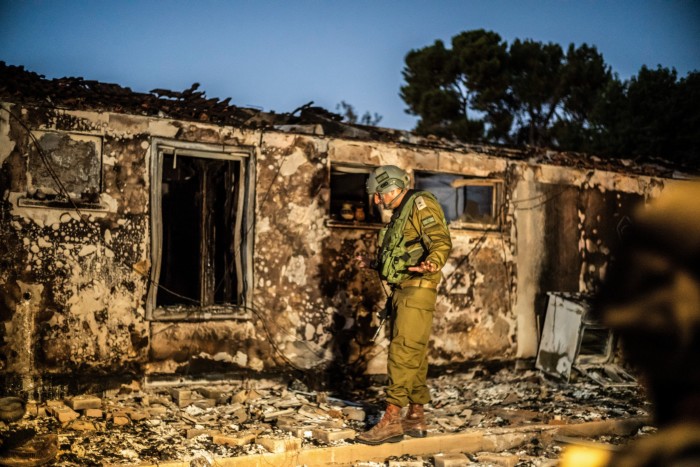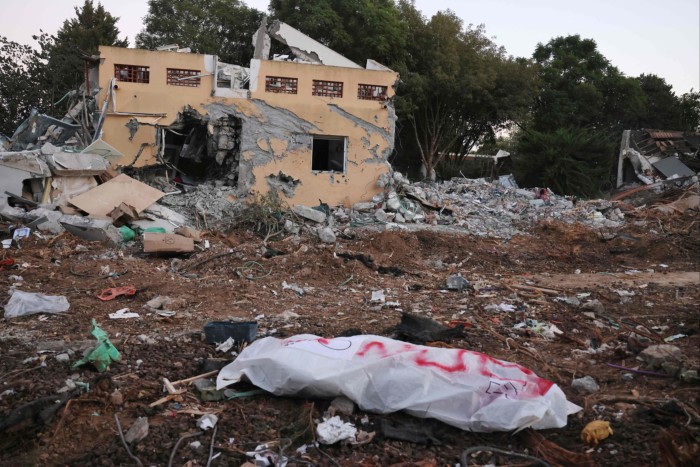Unlock the Editor’s Digest for free
Roula Khalaf, Editor of the FT, selects her favourite stories in this weekly newsletter.
The smell of rotting flesh permeated the air on Wednesday at Kibbutz Be’eri, a farming community near Israel’s border with the Gaza Strip that was one of the last communities to be freed from Hamas gunmen this week.
About two dozen bodies in white plastic bags lay arrayed on a lawn. Another two lay on a street alongside a kindergarten, victims of an assault which sent terrified residents into hiding in locked rooms, where they waited for help for more than 48 hours.
As Israel’s military opened Be’eri to journalists for the first time on Wednesday, a military official said that soldiers had found the bodies of 110 people, including women and children. Only the bodies of the attackers remained, he said; wrapped in white plastic bags, one of the corpses was spray painted in red with the word mekhabel, or terrorist.
Some of the kibbutz’s houses still had their lights on, apparently left untouched since the day of the attack, which Israelis now recognise as the biggest mass killing since the country’s founding in 1948. More than 1,200 people have been found dead in Israel, officials say, and every day new bodies are being found as they also try to account for missing people who they fear have been kidnapped into Gaza.
According to an Israeli military official, the attackers who broke through Israel’s security barrier with the enclave descended at about 6.30am on Saturday, the Jewish Sabbath and a holiday weekend.

“Hundreds of terrorists came from many directions into the kibbutz,” said Major General Itai Veruv. “I served almost 40 years in all the main operations and wars in Israel over the last four decades; I never saw something like this.”
A burnt-out house with scorched walls matched up with reports from Be’eri’s surviving residents, who have been evacuated elsewhere, that some of the attackers set fire to houses in an effort to force those inside outdoors. Several residential buildings were severely damaged or reduced to rubble because of what military officials said were tank operations to rescue residents of the kibbutz.
According to Israeli military officials, more than 100 Palestinians were killed in the operation to free the kibbutz. Even after the community was declared “clean” on Monday, Veruv said, stray Palestinian attackers continued to emerge for hours afterwards.
“When our grandfathers and grandmothers talk with us about the pogroms in Europe in the old days, we could not imagine it,” said Veruv, the military official. “And that’s why I say welcome to the war.”
The Gaza Envelope, as Israelis call the kibbutzim and farming communities that sit alongside the Hamas-ruled Palestinian enclave, is now a closed military zone. Thuds from outgoing Israeli artillery attacks on Gaza resound, along with regular alerts for incoming rockets that send soldiers to the ground for cover.

On Wednesday evening Be’eri was swarming with soldiers. On a road nearby, armoured vehicles raised dust through which cars put on their high beams to find their way.
The kibbutz is down the road from Re’im, the site of last weekend’s biggest mass atrocity, when about 250 people were slaughtered attending an all-night outdoor rave. Dozens of cars lay abandoned in a field where they had been parked, and coolers and other picnic paraphernalia lay strewn by the roadside.
At a military base in the Negev desert not far away, thousands of cars have been parked by the roadside, attesting to a major mobilisation of Israeli troops for what most expect to be a long war. The sound of gunfire resounded during a live ammunition drill.

